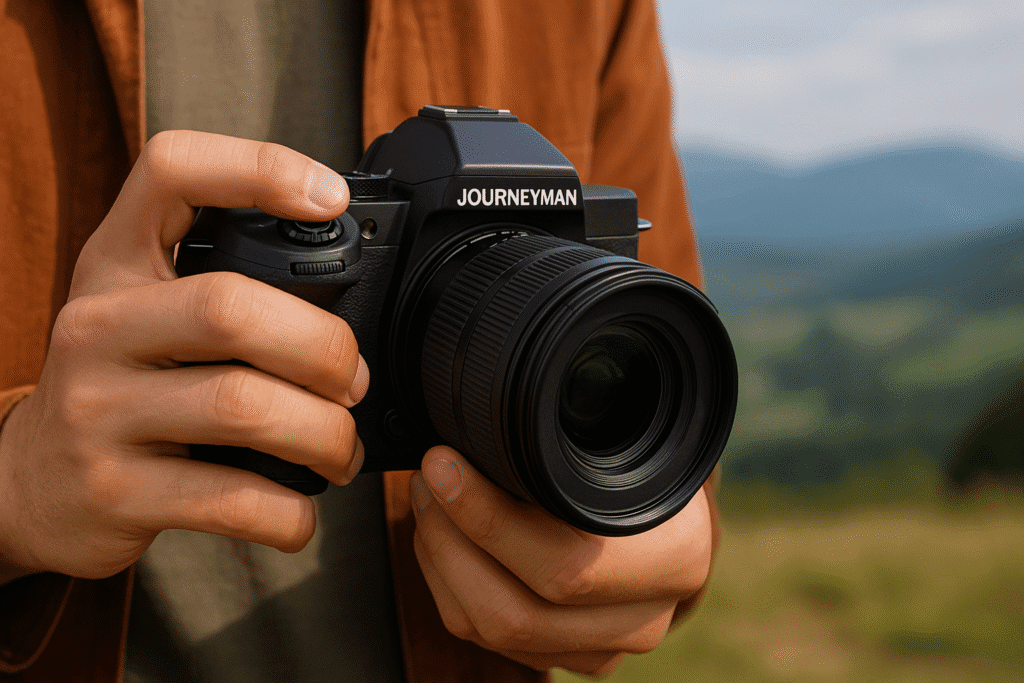
Exploring the features of the Journeyman Camera
What Is the Journeyman Camera All About?
In a world of high-end camera brands and feature alerts, the Journeyman Camera is slowly gaining notoriety with its fan base ahead. Promoted as a reliable mid-level, all-rounder suited to creators, travelers, and everyday shooters, it’s designed to offer professional-level images at an affordable price tag. There are so many that you can question whether this is the camera to trust with your memories or your creative work in 2025.
In this review, we go into all of the details of the Journeyman Camera, from the design to the performance and how it works in practice in the real world. We’re here to simplify it for you so you can determine if it’s worth your hard-earned money.
Why Everyone’s Talking About It
The Journeyman Camera boldly debuted with a hot new mix of today’s tech and the classic use-ability of the old days. With some content creators being tired of overly complex setups, pains in the ass to work with, etc., this stood out because it provided the few things we need; simple controls, reliable AF, and a healthy battery life. Social media buzz and positive unboxing videos only stoked the hype.
But of course, as we all know, a product can go viral on the web and still be a dud in actual practice. So we decided to try it out for ourselves.
First Impressions: Sleek or Standard?
You will see the quality matte finish when you open the box to the Journeyman Camera. It’s subtle, not flashy — its message is of quality, so do not look at me. The design is lightweight but strong, clearly meant for on-the-go shooters. Whether you dive, hike, commute, or attend an event – the camera can be stowed away easily in most camera bags, backpacks, or purses.
The buttons are minimal but well-placed, providing easy one-handed operation. Its rubberized, ergonomically designed grip adequately secures the camera for long shots. It’s not particularly revolutionary in form, but it feels like a thoughtfully made tool rather than a toy.
Durability and Portability for Daily Use
Regarding cameras, form is essential, but reliability will bring long-term commitment. Fortunately, the Journeyman does not disappoint. Constructed with a weather-sealed body that can easily handle light rain, dust , and moderate drops. You’ll be less afraid to go out on that spur-of-the-moment photo shoot or even take it while traveling when the road or conditions are challenging.
We also trialed it in several locations: a wet-weather hike to a sandy beach and a city event. And as it turned out, impressively, it’s held up perfectly fine with no signs of wear or atomic performance issues. Indeed, it deserves the badge of ”journey-ready” sidekick.
How Does It Handle in Real Conditions?
We took the Journeyman Camera for a spin in lighting and pointing situations. Hitting the pavement during the day and image quality is outstanding — sharp images, accurate colors, and good contrast. Af is surprisingly fast and doesn’t hunt much, even when switching subject to subject.
It still performs well in low light due to ISO performance or noise reduction algorithms. It won’t replace a high-end full-frame beast, but as a mid-tier option, it’s a contender. Footage of the action is crisp, with little blur while you’re trying to film something moving at any speed — which is not something every camera you’ll find in this price bracket can claim.
Low-Light, Motion, and Detail Test Results
Low-light shooting is a way of exposing the actual quality of a camera sensor, and it makes this camera sensor look good. The results were usable even in low light indoors or at twilight and didn’t need excessive editing. We experienced a little grain, but it was minimal.
Motion shots for cyclists and whizzing cars came out clear, courtesy of its advanced stabilization and tracking tech. Whether you’re vlogging or recording a dancing video created on time, the camera adjusts seamlessly and naturally. It maintained detail on the background and foreground shots — a feat that budget options tend to fail.
What Makes It Unique from Other Cameras?
What makes the Journeyman what it is isn’t just its components — it’s a balance of simplicity and performance. It doesn’t make an attempt to be everything but instead tries to make everything it does the best it can be. For example, the menu system is very friendly and doesn’t have the nested menu hell that others have.
You’ll also love its dual-lens compatibility, allowing you to switch between wide-angle and zoom easily. It has a rotatable LCD touchscreen ideal for selfies, vlogs, and those weird-angle shots. Add real-time image correction and intelligent color balancing, and you get the digicam that works on your behalf, not against it.
Smart Add-ons and Tech You’ll Use
No one wants gimmicks. Fortunately, tech that delivers some genuine usefulness is packed into the Journeyman. Key features include:
- Wifi and Bluetooth connectivity for sharing right from your device
- Built-in microphone and headphone jack for video recording
- In-camera RAW editing for on-the-go touch-ups
- Intelligent Auto Mode that analyzes your scene and adjusts settings
What we liked is that time-lapse and panorama modes have not just been tacked on but feel like fully operational, top-grade shooting options. For any pro-level production work, you’re not going to feel a need for third-party apps or accessories.
Setup, Usability, and Ease of Access
It is refreshing how little work one must go to to start with the Journeyman Camera. It’s seamless, from popping in the battery to formatting the SD card. The UI is beginner-friendly but is also powerful for seasoned photographers.
It comes with a quick start manual with QR codes for video tutorials — a nice touch for beginners. Thanks to the well-thought-out UI, it’s even easy to venture into manual settings. The touchscreen is responsive, and you can program buttons for your most-used features.
In other words, it does respect your time and your learning curve.
How It Feels for Beginners vs. Pros
The Journeyman Camera feels friendly but unrestricted, for beginners at least. Auto mode is excellent for point-and-shoot simplicity, and built-in tips pop up to assist when necessary. It is a good tool for pros or semi-pros, as it features complete manual control, interchangeable lenses, and RAW support.
We had a hobbyist and a wedding photographer try it out. The hobbyist thought it was great, while the pro-rated it better than expected, especially for simple jobs or behind-the-scenes stuff. It’s not designed to replace a pro-style DSLR, but it sure can give one a run for its money.
Can It Last Through a Full Day Shoot?
Yes—and then some. The battery life is one of the camera’s greatest strengths. We managed to get 9+ hours of standard photo/video use before it needed a charge. Video recording (1080p/60fps) consumed more power but was suitable for an entire event-length shoot.
The USB-C charging is fast, and you can charge with power banks, perfect for traveling. It uses a pair of SD card slots for storage, affording you flexibility for extended sessions or in-the-field backup.
Storage Options and File Handling
The camera processes large file sizes quickly. And with two card slots, you can split RAW and JPEGs or have an automatic backup on one card. The transfer speed is fast if you use USB-C, and there is built-in wifi file transfer for phones, cloud storage, etc.
For content creators, you will surely appreciate the file labeling and sorting tools built into the system. No more trolling folders looking for “IMG_4958.”
Price vs. Value Breakdown
At under $800, it’s affordable by today’s camera standards. Given the robust feature set, substantial battery, and high-quality image output, we may go on a limb and say you’re getting more than your money’s worth.
Where many cameras make you pay extra for things like flip screens or mic jacks, the Journeyman has them out of the box. It’s for budget-conscious users who don’t want to skimp on picture quality.
What Real Users Are Saying
The online reviews are generally positive. It is widely praised by users on forums for its reliability, particularly when traveling or at live events. Here are a few typical emotions:
- “Excellent travel buddy — light and reliable!”
- “Treated my wedding vlog like a pro.”
- “Battery life is top of the line at this price.”
Negative reviews were sparse but featured minor complaints, such as no 4K at 60fps or a limited lens ecosystem (which the brand is trying to grow).
Best Use Cases: Travel, Vlogging, or Pro Shoots?
The Journeyman Camera is perfect for:
- Travel vloggers desire reliability without bulk
- Content creators on a budget
- Amateur photographers who are studying the manual modes
- Event coverage and behind-the-scenes shooting
If you’re doing studio-level commercial work, you may need more. But for the day-to-day content and visual storytelling, it’s a great choice.
Is It a Smart Buy in 2025?
Absolutely. The Journeyman Camera is not only a cheaper option — it’s an intelligent choice. It ticks the boxes for quality, practicality, and longevity. It may not beat $2,000 flagship cameras, but it’s a top-tier performer within its range.
The answer for hobbyists, travel creators, and part-time pros is simple: Yes, the 16-inch MacBook Pro is worth your hard-earned money.
FAQs
What type of user is the Journeyman Camera best for?
It’s perfect for content creators, travel vloggers, and photographers ranging from light hobbyists to little more than amateur enthusiasts who want high quality without the hassle.
Does it support interchangeable lenses?
Yes, it has lens swaps, and it does work with a slew of third-party lenses using the appropriate adapter.
How long does the battery last on a full charge?
So you’ll be able to use it all day, on even the most extended shoots.
Can the camera shoot in 4K?
It shoots 4K video at 30 frames per second (fps) with smooth performance and decent stabilization.
Is the Journeyman Camera suitable for low-light conditions?
Yes, it’s pretty good for low light; for what you pay for, you get plenty of detail and not too much noise.






